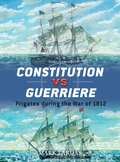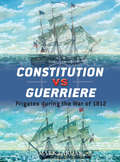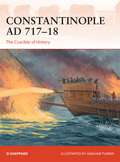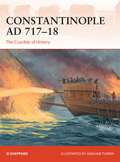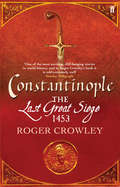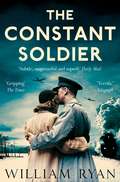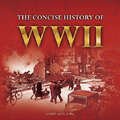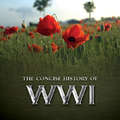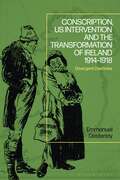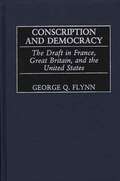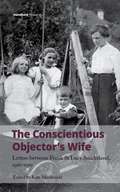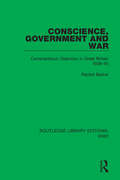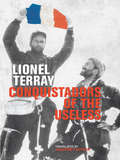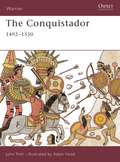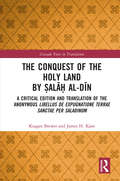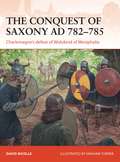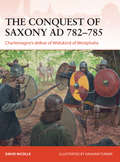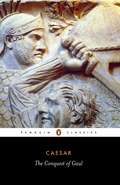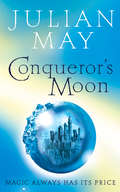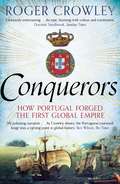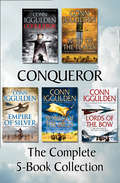- Table View
- List View
Constitution vs Guerriere: Frigates during the War of 1812 (Duel)
by Peter Bull Giuseppe Rava Mark LardasFamed as a classic naval duel, a one-on-one clash between two sailing frigates offered the victor immeasurable fame and glory. During the War of 1812, the Royal Navy and United States Navy squared off in four such duels, the most famous that between the USS Constitution and HMS Guerrière. Ships and tactics between the two nations varied enormously, with the American navy favouring a revolutionary design of frigate, with twenty-four pounder guns and heavy structural timbers, while the British, used to fighting the French and Spanish navies, relied on smaller, eighteen-pounder frigates. Through first-hand accounts of these four single-ship actions and fascinating comparisons of artillery, crew ability and tactical achievements, this book offers an unparalleled insight into the ruthless reality of frigate battles in the War of 1812.
Constitution vs Guerriere: Frigates during the War of 1812 (Duel #19)
by Peter Bull Giuseppe Rava Mark LardasFamed as a classic naval duel, a one-on-one clash between two sailing frigates offered the victor immeasurable fame and glory. During the War of 1812, the Royal Navy and United States Navy squared off in four such duels, the most famous that between the USS Constitution and HMS Guerrière. Ships and tactics between the two nations varied enormously, with the American navy favouring a revolutionary design of frigate, with twenty-four pounder guns and heavy structural timbers, while the British, used to fighting the French and Spanish navies, relied on smaller, eighteen-pounder frigates. Through first-hand accounts of these four single-ship actions and fascinating comparisons of artillery, crew ability and tactical achievements, this book offers an unparalleled insight into the ruthless reality of frigate battles in the War of 1812.
Constantinople AD 717–18: The Crucible of History (PDF)
by Si SheppardThe siege of Constantinople in AD 717–18 was the supreme crisis of Western civilization. The Byzantine Empire had been reeling under the onslaught of Arabic imperialism since the death of the Prophet, whilst Jihadist armies had detached Syria, Palestine, Egypt, and Carthage from imperial control and were in the process of imposing their ascendancy at sea. The Empire had been reduced to its Anatolian and Balkan heartland, and Arab incursions threatened even this – Arab naval forces had appeared under the walls of Constantinople every year from AD 674 to 678. But all this was only a prelude to the massive combined-arms invasion force that advanced on the capital in 717. This title offers a comprehensive study of the ensuing clash between the ascendant Caliphate and the Empire at bay. It details the forces available to each side, with their respective advantages and vulnerabilities, evaluating the leadership qualities of the rival commanders and assessing their strategic and tactical initiatives. It also accounts for the trajectory and outcome of the campaign and emphasises the fundamental significance of the struggle. By holding the line, the Byzantines gave Europe enough time to develop at its own pace and emerge strong enough to face down its Islamic counterpart on equal terms. If Constantinople had fallen in 717, could Europe have endured as an independent entity? Could Christianity have survived as major religion? What would the future course of world history have been?
Constantinople AD 717–18: The Crucible of History (Campaign #347)
by Si SheppardThe siege of Constantinople in AD 717–18 was the supreme crisis of Western civilization. The Byzantine Empire had been reeling under the onslaught of Arabic imperialism since the death of the Prophet, whilst Jihadist armies had detached Syria, Palestine, Egypt, and Carthage from imperial control and were in the process of imposing their ascendancy at sea. The Empire had been reduced to its Anatolian and Balkan heartland, and Arab incursions threatened even this – Arab naval forces had appeared under the walls of Constantinople every year from AD 674 to 678. But all this was only a prelude to the massive combined-arms invasion force that advanced on the capital in 717. This title offers a comprehensive study of the ensuing clash between the ascendant Caliphate and the Empire at bay. It details the forces available to each side, with their respective advantages and vulnerabilities, evaluating the leadership qualities of the rival commanders and assessing their strategic and tactical initiatives. It also accounts for the trajectory and outcome of the campaign and emphasises the fundamental significance of the struggle. By holding the line, the Byzantines gave Europe enough time to develop at its own pace and emerge strong enough to face down its Islamic counterpart on equal terms. If Constantinople had fallen in 717, could Europe have endured as an independent entity? Could Christianity have survived as major religion? What would the future course of world history have been?
Constantinople: The Last Great Siege, 1453
by Roger Crowley'Engagingly fresh and vivid . . . The 21-year-old Mehmet [the Ottoman Sultan] emerges from this book as ruthless but innovative, irascible but versatile and, above all, indefatigable - a worthy successor to Alexander and the Roman emperors he admired as much as any Muslim hero.' Malise Ruthven, Sunday TimesIn the spring of 1453, the Ottoman Turks advanced on Constantinople in pursuit of an ancient Islamic dream: capturing the thousand-year-old capital of Christian Byzantium. During the siege that followed, a small band of defenders, outnumbered ten to one, confronted the might of the Ottoman army in an epic contest fought on land, sea and underground.'In this account of the 1453 siege, written in crackling prose by former Istanbul resident Roger Crowley - his first book and not, I hope, his last - we are treated to narrative history at its most enthralling.' Christopher Silvester, Daily Express'A vivid and readable account of the siege . . . [And] an excellent traveller's guide to how and why Istanbul became a Muslim city.' Philip Mansel Guardian
The Constant Soldier
by William Ryan'Haunting, passionate, William Ryan’s The Constant Soldier is a subtle WW2 thriller of horror and love with an utterly gripping countdown to Gotterdamerung.' - Simon Sebag Montefiore, author of Red Sky at Noon.Shortlisted for the HWA Endeavour Ink Gold Crown.1944. Paul Brandt, a soldier in the German army, returns wounded and ashamed from the bloody chaos of the Eastern front to find his village home much changed and existing in the dark shadow of an SS rest hut – a luxurious retreat for those who manage the concentration camps, run with the help of a small group of female prisoners who – against all odds – have so far survived the war. When, by chance, Brandt glimpses one of these prisoners, he realizes that he must find a way to access the hut. For inside is the woman to whom his fate has been tied since their arrest five years before, and now he must do all he can to protect her. But as the Russian offensive moves ever closer, the days of this rest hut and its SS inhabitants are numbered. And while hope – for Brandt and the female prisoners – grows tantalizingly close, the danger too is now greater than ever. And, in a forest to the east, a young female Soviet tank driver awaits her orders to advance . . .
The Consise History of WWII
by Liam McCannBy 1938 a second war in Europe seemed inevitable. It had only been twenty years since the war to end all wars, and the horrors of conflict were still fresh in the mind, but that didn't stop all sides re-arming and preparing for yet more bloodshed. The settlement at the end of World War One was neither clean nor decisive, and it punished Germany by confiscating territory and forcing the people to pay reparations to help rebuild France and reduce the Allied debt to America. This led to deep-seated anger and resentment among its people.
The Consise History of WWI
by Pat MorganOn 28 June 1914 in Sarajevo, a Bosnian Serb student shot the heir to the throne of the Austro-Hungarian Empire. The assassination plunged the world into a global conflict that was to scar human history and redefine the meaning of the word war .
Conscription, US Intervention and the Transformation of Ireland 1914-1918: Divergent Destinies
by Emmanuel DestenayThis book analyses the relationship between the Irish home rule crisis, the Easter Rising of 1916 and the conscription crisis of 1918, providing a broad and comparative study of war and revolution in Ireland at the beginning of the Twentieth Century. Destenay skilfully looks at international and diplomatic perspectives, as well as social and cultural history, to demonstrate how American and British, foreign and domestic policies either thwarted or fed, directly or indirectly, the Irish Revolution. He readdresses-and at times redresses-the well established, but somewhat inaccurate, conclusion that Easter Week 1916 was the major factor in radicalizing nationalist Ireland. This book provides a more nuanced and gradualist account of a transfer of allegiance: how fears of conscription aroused the bitterness and mistrust of civilian populations from August 1914 onwards. By re-situating the Irish Revolution in a global history of empire and anti-colonialism, this book contributes new evidence and new concepts. Destenay convincingly argues that the fears of conscription have been neglected by Irish historiography and this book offers a fresh appraisal of this important period of history.
Conscription, US Intervention and the Transformation of Ireland 1914-1918: Divergent Destinies
by Emmanuel DestenayThis book analyses the relationship between the Irish home rule crisis, the Easter Rising of 1916 and the conscription crisis of 1918, providing a broad and comparative study of war and revolution in Ireland at the beginning of the Twentieth Century. Destenay skilfully looks at international and diplomatic perspectives, as well as social and cultural history, to demonstrate how American and British, foreign and domestic policies either thwarted or fed, directly or indirectly, the Irish Revolution. He readdresses-and at times redresses-the well established, but somewhat inaccurate, conclusion that Easter Week 1916 was the major factor in radicalizing nationalist Ireland. This book provides a more nuanced and gradualist account of a transfer of allegiance: how fears of conscription aroused the bitterness and mistrust of civilian populations from August 1914 onwards. By re-situating the Irish Revolution in a global history of empire and anti-colonialism, this book contributes new evidence and new concepts. Destenay convincingly argues that the fears of conscription have been neglected by Irish historiography and this book offers a fresh appraisal of this important period of history.
Conscription and Democracy: The Draft in France, Great Britain, and the United States (Contributions in Military Studies)
by George Q. FlynnFinding the manpower to defend democracy has been a recurring problem. Russell Weigley writes: The historic preoccupation of the Army's thought in peacetime has been the manpower question: how, in an unmilitary nation, to muster adequate numbers of capable soldiers quickly should war occur. When the nature of modern warfare made an all-volunteer army inadequate, the major Western democracies confronted the dilemma of involuntary military service in a free society. The core of this manuscript concerns methods by which France, Great Britain, and the United States solved the problem and why some solutions were more lasting and effective than others. Flynn challenges conventional wisdom that suggests that conscription was inefficient and that it promoted inequality of sacrifice.Sharing similar but not identical diplomatic outlooks, the three countries discussed here were allies in world wars and in the Cold War, and they also confronted the problem of using conscripts to defend colonial interests in an age of decolonization. These societies rest upon democratic principles, and operating a draft in a democracy raises several unique problems. A particular tension develops as a result of adopting forced military service in a polity based on concepts of individual rights and freedoms. Despite the protest and inconsistencies, the criticism and waste, Flynn reveals that conscription served the three Western democracies well in an historical context, proving effective in gathering fighting men and allowing a flexibility to cope and change as problems arose.
The Conscientious Objector's Wife: Letters Between Frank and Lucy Sunderland, 1916-1919 (PDF)
by Kate MacdonaldFrank and Lucy Sunderland, English pacifists and fervent supporters of Labour politics and the Garden City movement, were separated in 1916 when Frank was given his prison sentence for being a conscientious objector. They wrote to each other from November 1916 until April 1919, while Frank was incarcerated at Wandsworth and Bedford prisons. Lucy looked after their three children in Letchworth, and earned enough to keep the family afloat by keeping hens, collecting insurance premiums and taking in sewing. This unique collection of letters is important as a working-class record of wartime experience. These letters show how their shared ideology of a socialist pacifism upheld the couple in separation, planning for a better future in a more equal society for all. The letters give contemporary evidence of events on the Letchworth Home Front: spotting airships, food rationing, hearing the London air-raids, the arrival of ‘Spanish flu’ in 1918, and the sufferings of the European civilian populations immediately after the war. For readers interested in the First World War, British politics, the Garden City movement, feminism and women’s emancipation, adult and workers’ education, Quakerism and pacifism
Conscience, Government and War: Conscientious Objection in Great Britain 1939–45 (Routledge Library Editions: WW2 #6)
by Rachel BarkerThis book, first published in 1982, is a systematic and detached analysis of the 60,000 British conscientious objectors in the Second World War, forming an examination of the relationship between the individual and the State in time of war. It sets out to show how the British Government dealt with the challenge that conscientious objectors posed and how far it was able to correct the abuses and injustices that occurred in the First World War. It traces the background of pacifism between the Wars and the introduction of conscription, and gives a detailed account of the functioning of the Conscientious Objectors’ Tribunals and an assessment of their work. It goes on to examine the reactions and attitudes of Tribunal members, employers and the rest of the population, and how these were affected by the Government lead. It recounts the experience of objectors in civilian life and private and public employment, and how they fared in the armed forces and prisons. It also assesses the contributions made by the voluntary organisations who helped conscientious objectors in the war.
Conscience, Government and War: Conscientious Objection in Great Britain 1939–45 (Routledge Library Editions: WW2 #6)
by Rachel BarkerThis book, first published in 1982, is a systematic and detached analysis of the 60,000 British conscientious objectors in the Second World War, forming an examination of the relationship between the individual and the State in time of war. It sets out to show how the British Government dealt with the challenge that conscientious objectors posed and how far it was able to correct the abuses and injustices that occurred in the First World War. It traces the background of pacifism between the Wars and the introduction of conscription, and gives a detailed account of the functioning of the Conscientious Objectors’ Tribunals and an assessment of their work. It goes on to examine the reactions and attitudes of Tribunal members, employers and the rest of the population, and how these were affected by the Government lead. It recounts the experience of objectors in civilian life and private and public employment, and how they fared in the armed forces and prisons. It also assesses the contributions made by the voluntary organisations who helped conscientious objectors in the war.
Conquistadors of the Useless: From the Alps to Annapurna
by Lionel Terray'I have given my whole life to the mountains. Born at the foot of the Alps, I have been a ski champion, a professional guide, an amateur of the greatest climbs in the Alps and a member of eight expeditions to the Andes and the Himalayas. If the word has any meaning at all, I am a mountaineer.' So Terray begins Conquistadors of the Useless- not with arrogance, but with typical commitment. One of the most colourful characters of the mountaineering world, his writing is true to his uncompromising and jubilant love for the mountains. Terray was one of the greatest alpinists of his time, and his autobiography is one of the finest and most important mountaineering books ever written. Climbing with legends Gaston Rébuffat, Maurice Herzog and Louis Lachenal, Terray made first ascents in the Alps, Alaska, the Andes, and the Himalaya. He was at the centre of global mountaineering at a time when Europe was emerging from the shadow of World War II, and he came out a hero. Conquistadors tells of his war-time escapades, of life as an Alpine mountain guide, and of his climbs - including the second ascent of the Eiger North Face and his involvement in the first ever ascent of an 8,000-metre peak, Annapurna. His tales capture the energy of French post-war optimism, a time when France needed to re-assert herself and when climbing triumphs were more valued than at any other time in history. Terray's death, in the Vercors, robbed mountaineering of one of its most passionate and far-sighted figures. His energy, so obvious in Conquistadors of the Useless, will inspire for generations to come. A mountaineering classic.
The Conquistador: 1492–1550 (Warrior)
by Adam Hook John PohlMany accounts portray the conquest of the New World as a remarkable military achievement, with Cortés' vastly outnumbered but better armed Spaniards defeating hordes of superstitious savages. However, the reality of these events is far more complex and no less significant. The first Conquistadors who had sailed in search of prosperity, inspired by dreams of unlimited riches, soon became disillusioned and restless. With disease rampant, resources exhausted, and the Caribbean populations dwindling, they had little alternative but to find new territories and peoples to exploit. This title shows how, bolstered by influxes of war-hardened veterans from Europe and an army of over 30,000 allied Indian troops, they came to rely on and perfect what they knew best killing for profit, and without mercy.
The Conquistador: 1492–1550 (Warrior #Vol.40)
by John Pohl Mr Adam HookMany accounts portray the conquest of the New World as a remarkable military achievement, with Cortés' vastly outnumbered but better armed Spaniards defeating hordes of superstitious savages. However, the reality of these events is far more complex and no less significant. The first Conquistadors who had sailed in search of prosperity, inspired by dreams of unlimited riches, soon became disillusioned and restless. With disease rampant, resources exhausted, and the Caribbean populations dwindling, they had little alternative but to find new territories and peoples to exploit. This title shows how, bolstered by influxes of war-hardened veterans from Europe and an army of over 30,000 allied Indian troops, they came to rely on and perfect what they knew best killing for profit, and without mercy.
The Conquest of the Holy Land by Ṣalāḥ al-Dīn: A critical edition and translation of the anonymous Libellus de expugnatione Terrae Sanctae per Saladinum (Crusade Texts in Translation)
by Keagan Brewer James KaneThe Libellus de expugnatione Terrae Sanctae per Saladinum (or Little Book about the Conquest of the Holy Land by Ṣalāḥ al-Dīn) is the most substantial contemporary Latin account of the conquest of the Kingdom of Jerusalem in 1187. Seemingly written by a churchman who was in Jerusalem itself when the city was besieged and captured, the Libellus fuses historical narrative and biblical exegesis in an attempt to recount and interpret the loss of the Holy Land, an event that provoked an outpouring of grief throughout western Christendom and sparked the Third Crusade. This book provides an English translation of the Libellus accompanied by a new, comprehensive critical edition of the Latin text and a detailed study in the introduction.
The Conquest of the Holy Land by Ṣalāḥ al-Dīn: A critical edition and translation of the anonymous Libellus de expugnatione Terrae Sanctae per Saladinum (Crusade Texts in Translation)
by Keagan Brewer James KaneThe Libellus de expugnatione Terrae Sanctae per Saladinum (or Little Book about the Conquest of the Holy Land by Ṣalāḥ al-Dīn) is the most substantial contemporary Latin account of the conquest of the Kingdom of Jerusalem in 1187. Seemingly written by a churchman who was in Jerusalem itself when the city was besieged and captured, the Libellus fuses historical narrative and biblical exegesis in an attempt to recount and interpret the loss of the Holy Land, an event that provoked an outpouring of grief throughout western Christendom and sparked the Third Crusade. This book provides an English translation of the Libellus accompanied by a new, comprehensive critical edition of the Latin text and a detailed study in the introduction.
The Conquest of Saxony AD 782–785: Charlemagne's defeat of Widukind of Westphalia (Campaign)
by David Nicolle Graham TurnerCharlemagne's conquest of the Saxons was the hardest fought and most protracted of his wars; it involved 18 campaigns spread across 33 years, a great deal of lower-level fighting and the harshest final peace settlement that Charlemagne ever imposed upon a defeated foe. Rapidly taking on the character of a religious conquest from its outset, it also became the most important of all Charlemagne's wars for the future direction and character of European history and began the long process of uniting the German-speaking peoples. With extensive photographs, full colour artworks, maps and bird's-eye-views, this volume unravels the initial stages of a convoluted sequence of events that led to the conquest of the Saxons and ultimately Charlemagne's consolidation of Saxony into the greater Carolingian Empire.
The Conquest of Saxony AD 782–785: Charlemagne's defeat of Widukind of Westphalia (Campaign #271)
by David Nicolle Graham TurnerCharlemagne's conquest of the Saxons was the hardest fought and most protracted of his wars; it involved 18 campaigns spread across 33 years, a great deal of lower-level fighting and the harshest final peace settlement that Charlemagne ever imposed upon a defeated foe. Rapidly taking on the character of a religious conquest from its outset, it also became the most important of all Charlemagne's wars for the future direction and character of European history and began the long process of uniting the German-speaking peoples. With extensive photographs, full colour artworks, maps and bird's-eye-views, this volume unravels the initial stages of a convoluted sequence of events that led to the conquest of the Saxons and ultimately Charlemagne's consolidation of Saxony into the greater Carolingian Empire.
The Conquest of Gaul (Barnes And Noble Library Of Essential Reading)
by Julius Caesar Jane Gardner S. HandfordBetween 58 and 50BC Caesar conquered most of the area now covered by France, Belgium and Switzerland, and twice invaded Britain. This is the record of his campaigns.Caesar's narrative offers insights into his military strategy & paints a fascinating picture of his encounters with the inhabitant of Gaul and Britain, as well as offering lively portraits of a number of key characters such as the rebel leaders and Gallic chieftains. This can also be read as a piece of political propaganda, as Caesar sets down his version of events for the Roman public, knowing that he faces civil war on his return to Rome.
Conqueror’s Moon: Boreal Moon Tale
by Julian MayA powerful fantasy adventure filled with dark magic and deadly intrigue, from the worldwide bestselling author of the Saga of the Pliocene Exile.
Conquerors: How Portugal seized the Indian Ocean and forged the First Global Empire
by Roger CrowleyAs remarkable as Columbus and the conquistador expeditions, the history of Portuguese exploration is now almost forgotten. But Portugal's navigators cracked the code of the Atlantic winds, launched the expedition of Vasco da Gama to India and beat the Spanish to the spice kingdoms of the East - then set about creating the first long-range maritime empire. In an astonishing blitz of thirty years, a handful of visionary and utterly ruthless empire builders, with few resources but breathtaking ambition, attempted to seize the Indian Ocean, destroy Islam and take control of world trade.Told with Roger Crowley's customary skill and verve, this is narrative history at its most vivid - a epic tale of navigation, trade and technology, money and religious zealotry, political diplomacy and espionage, sea battles and shipwrecks, endurance, courage and terrifying brutality. Drawing on extensive first-hand accounts, it brings to life the exploits of an extraordinary band of conquerors - men such as Afonso de Albuquerque, the first European since Alexander the Great to found an Asian empire - who set in motion five hundred years of European colonisation and unleashed the forces of globalisation.
Conqueror: The Complete 5-Book Collection
by Conn IgguldenConn Iggulden’s No.1 bestselling series, which tells the epic story of Genghis Khan, his warrior sons, and their fight to rule an empire, now in one complete eBook for the first time.
